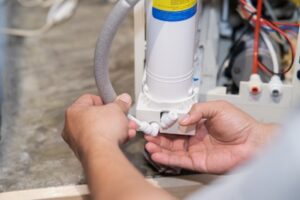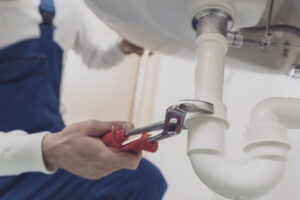Water Filtration: The Types of Faucet Water Filters and Installation Process
A faucet water filter is a device that is attached to your faucet to filter the water that comes out of it. If you wish to improve the taste and quality of your drinking water, a faucet water filter is an easy way to do it. They include different styles, shapes, and materials. So what are the different types of faucet water filters and how do you install them?
Water Filtration: Types of Faucet Water Filters
- Carbon Filter Water Filter
- Reverse Osmosis Water Filter
- Ultraviolet Light Water Filter
- Activated Alumina Water Filter
- A Pitcher Filter
- Inline Filter
- Countertop Filter
- Under-Sink Filter
The Installation Process for Water Filtration:
- Shut off the water supply to the faucet
- Remove the existing aerator
- Connect the adapter
- Assemble the Base and Filter Cartridge
- Test your connections
So, now that you have an idea of the different types of water filtration water faucet filters and the installation process for them, let’s examine all of this in greater detail. So, keep reading this find this out and more!

Popular Types of Faucet Filters
When it comes to water, you want to ensure that it is as clean and pure as possible. Faucet filters aid in the purification of your water by removing impurities such as; chlorine, lead, and other contaminants. The various types of faucet filters are listed below:
A Carbon Filter Water Filter
These filters are the most popular type of faucet water filter, and they aid in the removal of chlorine and other chemicals from your water. Carbon filters work by absorbing particles/impurities in their activated carbon pores—the tiny openings in their filtration system—to ensure that only clean water flows through them into your sink or tub.
A Reverse Osmosis Water Filter
For the purification of water, a reverse osmosis filter is the most suitable option. Although this filter is much more expensive than other types of filtration systems—however, they are generally considered to be more effective. It works by forcing the water through an ultra-fine permeable membrane.

An Ultraviolet Light Water Filter
UV light is used to destroy bacteria, viruses, and other microbes in water. It is equally great for removing chemicals from your water. It is necessary to note that UV lights are not suitable for purifying chemical-laden water (you may want to look into reverse osmosis if you need that).
An Activated Alumina Water Filter
This filter comprises aluminum oxide, and it is used in the removal of chemicals and heavy metals. It is also used in reverse osmosis systems for the treatment of drinking water, but it is not effective against bacteria or viruses.
A Pitcher Filter
These are simple devices that resemble pitchers and sit on your countertop or next to your sink. They are easy to use and portable, so you can take them with you wherever you go. They are also inexpensive, thus making them an excellent choice for most households. However, they are not as effective in the removal of bacteria and other contaminants from water as some other types of filters (like reverse osmosis). This means that if there is a lot of sediment in your water—which tends to happen when cities use old pipes—you will need more frequent cleanings than with other types of faucets.
An Inline filter
These are usually installed under the sink, and they are used together with a faucet-mounted filter. Inline filters are useful in the filtration of drinking or cooking water, but they are not meant to be used as a standalone unit. Inline filters work by removing sediment from your water before it enters your pipes. They contain some sort of filtration material inside them—this allows them to absorb more impurities from the water.
A Countertop Filter
Countertop filters are quick to install. They adopt the advanced activated carbon block which helps in the reduction of heavy metals, and impurities in water.
An Under-Sink Filter
These filters are usually installed under your kitchen sink, so you cannot see them or use them until after turning on your faucet. They have a separate faucet and usually connect to the cold-water line.
Ensuring the purity of your drinking water is crucial, especially in light of the health risks associated with contaminated water. One prominent case highlighting the consequences is the Camp Lejeune water contamination lawsuit, where residents faced severe health issues due to exposure to toxic substances. Installing a reliable faucet water filter is a proactive safeguard against contaminants such as chlorine, lead, and other impurities. As you explore the various types of faucet water filters, remember the significance of protecting your health and consider the specific needs of your water source. In today’s world, where water quality concerns persist, a well-chosen faucet water filter can make a substantial difference in maintaining a clean and safe water supply for your household.
How to Install a Faucet Water Filter
There are different tools needed during the installation of a faucet water filter, each of these tools is used depending on the type of filter you are installing. These are the things you need.
- Tape Measure ;
- Shifter ;
- Spanner ;
- Hammer ;
- Nail punch ;
- Drill ;
- Drill bits ;
- Screws ;
- Screwdriver ;
- Cutter ;
- Stanley Knife.
The typical process for how to install a faucet water filter is briefly highlighted below;
1. Shut off the water supply to the faucet
Begin by turning off the water supply to your faucet: How do I turn off my water? The easiest way is to flip a switch on your wall or sink
2. Remove the existing aerator
To remove your aerator, turn off the water supply to your home and use a wrench to pry it off. Make sure you follow the manufacturer’s instructions when removing an aerator from its base because some models require special tools for removal or replacement.

3. Connect the adapter
Attach the adapter to the filter housing, then connect it to your faucet by attaching it on both sides of its threaded connection with pliers or a wrench.
The filter housing must be securely attached to the adapter before installing it into your faucet. Make sure that both parts are fully tightened by hand, then use a wrench if necessary (be careful not to over-tighten). If you are using an adjustable wrench, make sure that it is properly adjusted so as not to strip out any threads when tightening or loosening any fittings on your faucet assembly or adapter pieces; otherwise, you may damage them and void your warranty on them.
4. Assemble the Base and Filter Cartridge
Connect the base to the filter cartridge, making sure it is tight. Then, check that your faucet is connected appropriately. Finally, make sure that all connections have been made correctly—you may need help with this if you are not familiar with plumbing or do not have much experience installing fixtures like this one.
5. Test your connections
Test for leaks by turning on the faucet and checking for water flow through a hose or pipe in each room of your house.
Frequently Asked Questions
Should a water filter be put in a faucet?
Yes, it is important that you do, as this helps in reducing 99% of contamination in your water. These contaminants include bacteria, chlorine, lead, viruses, and other contaminants. You can attach the type of filter (as described above) to your faucet.
How often should a faucet filter be changed?
At best, a faucet filter should be changed every two to three months. Prolonged use of a filter without replacement can cause it to lose its effect, which would in turn lead to the contamination of your water. Most manufacturers often include the duration of use for a specific filter.It is important to note that a busier household and the quality of water in your home affect the life duration of a filter.
Do all activated carbon filters have the same level of effectiveness?
All carbon filters are not equally effective. The measure of their effectiveness is given by two factors: the amount of activated carbon in each unit, and the amount of time spent by the contaminant in the filter. Technically, the higher the carbon percentage in a filter, the better its filtration ability. There are three major carbon types used in an activated filter. They include wood, bituminous, and coconut shells. The coconut shell is considered to be the best of all three.
Conclusion
You can install a faucet water filter with the right tools in a couple of hours, but if you have trouble with plumbing then hiring someone who knows how to install them will save time and money. It is also a great way to ensure that the installation progress is smooth and you do not cause any damage to the building.
